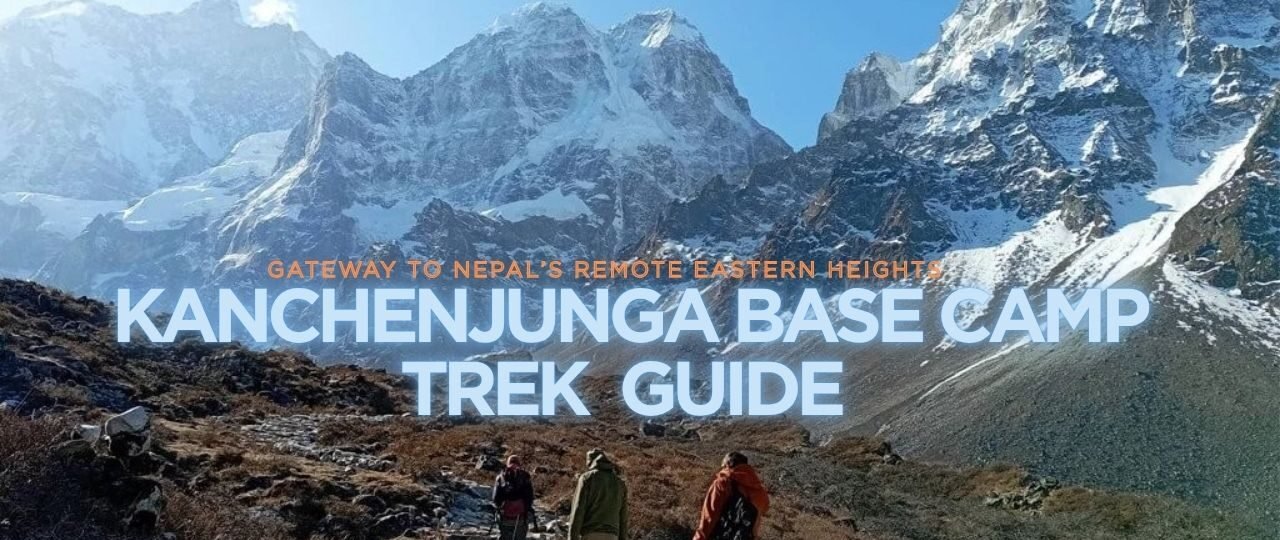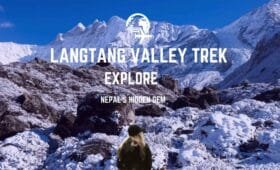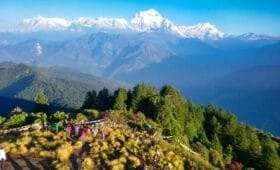The Kanchenjunga Base Camp Trek delivers a once-in-a-lifetime Himalayan experience for those craving unspoiled wilderness and authentic cultural encounters. The Kanchenjunga Trek, also known as the Kanchenjunga Circuit Trek, ventures into the far eastern reaches of Nepal—near the frontier with Sikkim and Tibet—offering diverse landscapes, towering peaks, and very few fellow trekkers. This region is home to Kanchenjunga, the world’s third-highest mountain at 8,586 meters, revered by locals for its spiritual aura and recognized globally for its environmental significance.
This comprehensive guide will dissect everything about the Kanchenjunga Base Camp Trek, from recommended routes, typical Kanchenjunga Base Camp Trek Itinerary details, and cost estimates to essential safety tips, weather patterns, and volunteering opportunities. We’ll also cover the best time to go, how to pick a reliable Kanchenjunga Base Camp Trek Package and vital permit information. Alongside practical data on Kanchenjunga Base Camp Trek Distance, difficulty, altitude adaptation, or gear lists, you’ll find insights into local culture, teahouse accommodations, and personal stories from those who’ve embraced this hidden Himalayan gem. Let’s deeply dive into the wonders of Kanchenjunga Base Camp Trek.
1. Introduction: Why Choose the Kanchenjunga Base Camp Trek?
The Kanchenjunga Base Camp Trek offers a route less traveled, untouched by the mass tourism seen in Annapurna or Everest. Trekkers stepping onto these trails find an authentic Himalayan culture shaped by ethnic groups like the Limbu, Rai, Sherpa, and others who have coexisted for centuries under the shadow of Kanchenjunga. This expedition satisfies hikers thirsting for remote serenity, varied wildlife habitats, and wide-reaching views of the Kanchenjunga massif.
Statistic: According to the Nepal Tourism Board, fewer than 3,000 trekkers attempt the Kanchenjunga Trek annually—drastically fewer than the tens of thousands frequenting Everest or Annapurna. This underscores the region’s status as a secluded wonderland. Despite the challenge of covering large distances and braving altitudes over 5,000 meters, travelers often find the trek’s raw beauty worth every step.
Quote:
“The silence around Kanchenjunga Base Camp felt surreal—like stepping back in time, far from modern distractions. Each day rewarded me with primal landscapes and the warm welcomes of local families,” recalls Andrea, a 34-year-old nurse who completed the route last fall.
2. Historical & Cultural Overview
Kanchenjunga—often spelled “Kangchenjunga”—derives from the Tibetan phrase “Kang-chen-zod-nga,” interpreted as “The Five Treasures of the Great Snow.” Historically revered by local communities as a holy mountain, climbers only gained official entry after Nepal opened eastern routes in the mid-1980s. While the region’s main towns, like Taplejung, have modernized, its highland villages still preserve ancient animist and Buddhist beliefs.
Cultural variety abounds: Chetri and Brahmin farmers inhabit lower hills, Limbu and Rai dwell at mid-range altitudes, and Tibetan-influenced Sherpas appear near the high ridges. This mosaic fosters richly diverse customs and colorful festivals. The local concept of “Bayulung” or “Kirat region” overlaps with these mountainous enclaves, linking heritage and environment in intangible ways. Embracing this tapestry enriches every day spent on the Kanchenjunga Base Camp Trek.
Trek Itinerary
3. Key Highlights of Kanchenjunga Base Camp Trek Itinerary
Kanchenjunga Circuit Trek can be approached in multiple ways, typically spanning 20–24 days, though some direct routes may be done in 15–17 days if skipping side excursions. A popular “North & South Base Camp” itinerary might look like this:
- Days 1–2: Kathmandu → Taplejung → Mitlung
A domestic flight from Kathmandu to Bhadrapur or Suketar (Taplejung) precedes a bumpy drive to Mitlung or Sinwa, the trek’s usual start. - Days 3–5: Chirwa, Sekathum, Amjilosa
Lower altitude days passing farmland, terraced slopes, and glimpses of local “limbu” culture. - Days 6–8: Gyabla, Ghunsa, Kambachen
Trails climb through pine and rhododendron forests. Ghunsa (~3,400m) is a significant rest spot, hosting a monastery and gateway to higher altitudes. - Days 9–10: Lhonak (4,780m) → Pangpema (North Base Camp ~5,143m)
These upper reaches are defined by crisp air, glaciers, and fewer teahouses. The Pangpema vantage point reveals the north face of Kanchenjunga. - Days 11–14: Return to Ghunsa → Sele La (4,290m)
Cross-challenging high passes like Sele La or Sinion La link with the southern circuit. - Days 15–18: Tseram → Ramche (South Base Camp ~4,600m)
This southwestern route offers vantage points of Yalung Glacier and the south face of Kanchenjunga. - Days 19–21: Descent via Tortong, Yamphudin
Re-enter mid-altitude farmland and pastoral villages, concluding near Taplejung.
Kanchenjunga Base Camp Trek Duration can vary widely, but 20 days is typical for a comprehensive “Circuit.” If time is limited, some skip the southern side. Add rest days in core villages like Ghunsa or Yamphudin for those wanting a thorough cultural immersion.
4. Understanding the Kanchenjunga Base Camp Trek Difficulty
The Kanchenjunga Base Camp Trek Difficulty ranks high relative to standard Nepali treks. Why?
- Isolation: Teahouses and supply lines are sparse. Bringing a guide, porters, or stocked gear is more crucial than on commercial routes.
- Altitude & Passes: The maximum altitudes are near 5,143m at Pangpema or ~4,600m at Ramche. Crossing Sele La or Mirgin La also tests stamina.
- Length & Terrain: ~20 days of trekking considerable daily distances in remote terrain means consistent endurance demands.
Fitness & Preparation:
- Acquire 6–8 weeks of cardio training (running, swimming).
- Incorporate hiking with loaded backpacks to mimic daily climbs.
- Complete a mid-level Himalayan trek (like Annapurna) before tackling Kanchenjunga.
5. Mapping Your Route: A Look at the Kanchenjunga Base Camp Trek Map
Because this route passes restricted areas, a Kanchenjunga Base Camp Trek Map is essential. Key stops and altitudes:
- Taplejung (Suketar): ~2,420m, potential airstrip or drive from Bhadrapur.
- Ghunsa: ~3,400m, major checkpoint, often an acclimatization break.
- Lhonak (4,780m): High altitude settlement for north base camp approach.
- Pangpema (North Base Camp): ~5,143m vantage point for glaciers and the Kanchenjunga massif.
- Sele La / Sinion La: ~4,290–4,663m passes, bridging the northern path to southwestern segments.
- Ramche / South Base Camp: ~4,600m, vantage on Yalung Glacier.
- Yamphudin: ~2,080m, reintroduction to farmland and roads leading back to Taplejung.
Mantra: Always confirm daily routes with a local guide. Trails can shift post-landslides or monsoons, making current knowledge invaluable.
6. How Much Does It Cost? Explaining the Kanchenjunga Base Camp Trek Cost
The Kanchenjunga Base Camp Trek Cost is higher than standard treks due to remote logistics and restricted permits. Factors:
- Permits:
- Restricted area permit: ~USD 20/week in low season (~USD 10 for subsequent weeks) or ~USD 30/week in peak season (plus ~USD 15 for subsequent weeks).
- Kanchenjunga Conservation Area Permit: ~USD 20–30.
- TIMS card: If not covered by restricted rules, ~USD 10–20.
- Guide & Porter:
- Mandatory licensed guide for restricted zones. ~USD 25–40/day.
- Porters: ~USD 15–25/day.
- Transport:
- Flight Kathmandu → Bhadrapur / Suketar or bus to Taplejung. Bhadrapur flights are USD 180–200 each way. Then, local jeeps ~ are USD 30–100.
- Teahouse Lodging & Meals:
- ~USD 5–8/day for a room in remote sections, plus USD 20–25 for three daily meals.
- Additional:
- Gear rentals, insurance, possible helicopter rescue deposit, tips.
A typical 20-day trek might cost USD 1,600–2,300, depending on whether you choose a complete Kanchenjunga Base Camp Trek Package or prefer partial services.
7. Booking the Right Kanchenjunga Base Camp Trek Package
Considering the region’s remoteness, many prefer a Kanchenjunga Base Camp Trek Package covering:
- Permits & Paperwork: Freed from bureaucratic hassle.
- Transportation: Coordinated flights/jeeps to/from Taplejung.
- Guide & Porters: Typically 1 guide for every 4–5 trekkers, plus 1 porter per 2 trekkers.
- Teahouse Reservations: Vital in peak months, ensuring shelter in remote spots.
- Meals: Some packages partially or fully include daily meals.
Group vs. Private:
- Group tours cost less, fueling camaraderie but fixed schedules.
- Private tours let you shape daily distances or side trips, albeit pricier.
8. Securing Kanchenjunga Base Camp Trek Permits
Since it’s a restricted area, all foreigners require:
- Restricted Area Permit:
- Issued via the Department of Immigration in Kathmandu or local authority.
- Must trek in a group of at least two plus a licensed guide.
- Kanchenjunga Conservation Area Permit: ~USD 20–30.
- TIMS: Possibly replaced by the restricted permit. Confirm current rules with your operator.
Carry multiple passport photos and your original passport to expedite the process. Show these at local checkpoints near Chirwa, Ghunsa, or Yamphudin.
9. Kanchenjunga Base Camp Trek Best Time: Seasons & Weather
Kanchenjunga Base Camp Trek Weather can be unpredictable, with monsoon rains in the lower altitudes and potential snowfall in the highest passes. The ideal Kanchenjunga Base Camp Trek Best Time is:
- Autumn (Sept–Nov): Crisp skies, stable conditions, moderate temperatures. Busy with global trekkers.
- Spring (Mar-May): Flowers bloom, especially rhododendrons, though some haze may form in afternoons.
- Winter (Dec–Feb): Sub-zero nights above ~3,500m, fewer trekkers, and potential closure of high passes if snow accumulates.
- Monsoon (Jun–Aug): Heavy rainfall, leeches in lower forests, but lesser crowds. Many find muddy or landslide-prone trails challenging.
10. Hiring a Kanchenjunga Base Camp Trek Guide
Guides are mandatory, but beyond legal necessity, they offer:
- Route Expertise: Minimizes confusion or risk of losing the trail in remote zones.
- Local Insight: Explaining village culture, festival traditions, or monastery customs.
- Safety & Support: A first line of help for altitude sickness, injuries, or crossing uncertain terrain.
Cost: ~USD 25–40/day, excluding tips. Some also hire a local cook team if they prefer camping in extra-remote segments. However, teahouses dot the route, making the standard trek style feasible.
Tips
11. Preparation & Tips for Success
11.1 Physical Training
- Cardio: At least 6 weeks of running, cycling, or swimming 3–5 times weekly.
- Strength: Weighted squats, lunges, or step climbs help for daily ascents, especially near high passes.
- Altitude Acclimatization: Consider prior mid-level treks or repeated practice hikes near 3,000m if possible.
11.2 Gear & Clothing
- Layers: Thermal base, mid-layer fleece, down jacket, waterproof shell.
- Footwear: High-quality trekking boots, well broken-in, plus optional microspikes if crossing snowy passes.
- Misc Items: Trekking poles, water purifier, robust sleeping bag (-10°C rating), plus personal first-aid kit.
11.3 Logistics & Infrastructure
Kanchenjunga Base Camp Trek Accommodation is typically basic teahouses, though some might prefer tented camping for more remote loops. Many teahouses remain open year-round, but services can be minimal in winter or monsoon.
Testimonials
12. Stories from the Trail: Testimonials & Inspiration
Miguel’s Reflection
Miguel, a 30-year-old software developer from Spain, shares: “I’d done Everest Base Camp prior, but the Kanchenjunga Circuit Trek topped it for serenity. Each day felt raw, with valleys unspoiled by mass tourism. The final approach to the north base camp was a spiritual high.”
Local Revival
Villagers along the route note that tourism fosters improvements in local schools, healthcare expansions, and road projects. But they also emphasize sustainable growth to preserve the environment. Tashi, a teahouse owner near Ghunsa, states, “We want to remain hidden from big crowds but still benefit from visitors who respect our culture.”
FAQs
13. Seven Most Frequently Asked Questions
How long is the Kanchenjunga Base Camp Trek Duration?
Typically, the entire circuit takes 20–24 days, though shorter versions may run ~15 days if only doing the north side.
What is the Kanchenjunga Base Camp Trek Difficulty level?
It’s challenging. Expect high passes, altitudes over 5,000m, and remote terrain with fewer rescue options.
How much does the Kanchenjunga Base Camp Trek Cost?
Including permits, guide, lodging, and food for ~20 days, budget ~USD 1,600–2,300. Costs can vary with group size and service standards.
Which permits are mandatory for the trek?
Restricted Area Permit, Kanchenjunga Conservation Area Permit (~USD 20–30), and sometimes a TIMS card if needed.
What is the best time for the Kanchenjunga Circuit Trek?
Autumn (Sept–Nov) and spring (Mar–May) remain the best months for stable weather. Winter is cold with possible pass closures, and the monsoon is muddy but quiet.
Do I need a Kanchenjunga Base Camp Trek Guide?
Yes, the region is restricted, so a licensed guide is required. They also offer route knowledge, cultural insight, and safety.
Is Kanchenjunga Base Camp Trek Map usage enough, or is a package recommended?
A map alone might not suffice in remote corners. Many prefer a package or a guide for logistical ease and route clarity.
Conclusion
From steep canyons and glacier-swept passes to quiet villages bound by age-old traditions, the Kanchenjunga Base Camp Trek encapsulates the pure essence of Himalayan adventure. The route’s demanding nature and raw, seldom-traveled paths ensure you earn the mesmerizing vistas of Kanchenjunga’s majestic summits. This is it if you yearn for an authentic, less-commercialized Himalayan trek.
Amplify Your Trekking Impact with ViN
Volunteers Initiative Nepal (ViN) invites you to transform your Kanchenjunga Trek into more than a personal goal. By weaving volunteering, donations, or internships into your itinerary, you cultivate deeper community connections and help sustain local lifestyles:
- Volunteer: Devote a few days assisting local health clinics or schools near Taplejung or mid-altitude villages.
- Intern: Research eco-preservation or community development, bridging academic pursuits with local solutions.
- Donate: Empower grassroots education, healthcare, and cultural preservation initiatives critical in remote Himalayan societies.
- Share: Inspire fellow travelers by recounting how your trek shaped philanthropic synergy across far-flung corners of Nepal.
Each step along the Kanchenjunga Base Camp Trek stands for forging empathy, bridging cultures, and sustaining an environment treasured by generations.
Namaste—and together, let’s craft a legacy of responsible tourism, fueling personal enrichment and community upliftment throughout these majestic mountains.
Extra Tips
Extra Info & Tips for Kanchenjunga Base Camp Trek
We’ve covered the fundamentals of the Kanchenjunga Circuit Trek, but let’s expand on crucial nuances. Below are additional pointers on route specifics, cultural courtesy, gear, and synergy with volunteering efforts.
1. Seasonal Breakdown & Kanchenjunga Base Camp Trek Weather
1.1 Autumn (Sept–Nov)
- Dry, stable, mild daytime (~15°C at mid-altitude), nights drop to near freezing at ~3,500m. Larkya Pass-level altitudes can hit -5°C or colder. Crisp mountain panoramas highlight the silhouette of Kanchenjunga.
1.2 Spring (Mar-May)
- Clear mornings, possible haze or storms in the afternoons. Rhododendrons and magnolia color the lower slopes. Peak blossoming around mid-April.
1.3 Winter (Dec–Feb)
- Fewer trekkers. Sub-zero nights above 3,000m. Paths might freeze near the passes. Certain teahouses in high altitudes might close for winter, requiring advanced planning or camping gear.
1.4 Monsoon (Jun–Aug)
- Heavy rainfall, muddy trails, and the risk of landslides in lower valleys typically make this period a less popular choice for visitors. However, the green vistas can be mesmerizing. For seasoned explorers craving solitude, it’s an adventurous but risky choice.
2. Variation: Shorter vs. Full Circuit
2.1 North Base Camp Only
If pressed for time, do the north side alone—reaching Pangpema (~5,143m) near ~12–14 days. Return the same route, skipping the southern approach.
2.2 Tented Expeditions
Some prefer an older style: setting up camps beyond Lhonak or around Sele La. This approach offers flexibility but demands more gear and cost for porters or a cooking crew.
3. Cultural Integration
3.1 Limbu & Rai Heritage
Their folk dances, Dhaan Naach or Sakela, occasionally coincide with festivals. If you’re near their villages during a cultural event, it’s worth pausing to witness the color and dance.
3.2 Foods
Try local “Tongba” (millet-based alcohol) in some mid-altitude stops. Yak butter tea or typical dal bhat are standard in higher settlements. Embrace these taste experiences while being mindful of hygiene.
4. Handling Trash & Environmental Respect
4.1 Trash Disposal
Remote zones rarely have sophisticated waste systems. Repack wrappers and plastic until you find a disposal site in Taplejung or bigger villages.
4.2 Water Filtration
Carrying a personal purifier or tablet helps avoid single-use plastic bottles. Many villages boil water for ~USD 1 per liter. If purified properly, drinking from glacial streams is an option.
5. Potential Dangers & Solutions
- Landslides in lower sections (especially monsoon) or avalanche risk near high passes.
- Hypothermia or frostbite at higher altitudes if gear is insufficient.
- Altitude Sickness: Take an extra day at Ghunsa or Kambachen if needed. Listen to your body.
6. Post-Trek Activities & Reflection
Once back in Taplejung, a bus or jeep takes you to Birtamod or Bhadrapur for a flight to Kathmandu. Many trekkers relish a day or two decompressing in capital hotels, indulging in city comforts. Reflecting in a personal journal clarifies how the trek broadened your perspective on mountain life, adversity, or personal endurance.
7. Volunteering with ViN in the Region
7.1 Extended Stays
If time allows, embed deeper. Help local schools near Taplejung with English lessons or sponsor library expansions. Partnerships with local women’s groups might revolve around handicrafts or small business training.
7.2 Impactful Philanthropy
Nepal’s eastern hills see fewer NGO projects than central regions. Your presence can fill that gap, whether funding a health post’s medical kit or establishing small reading corners. The satisfaction of merging trekking with giving resonates long after you exit the Himalayan trails.




